Types of Policies for the Joint Diffusion of Electric Vehicles with Renewable Energies and Their Use Worldwide
Abstract
:1. Introduction
2. Conceptual Background
2.1. Policies to Increase EV Adoption in Low-Carbon Technology Transitions
2.2. Policies to Improve RES Share in Low-Carbon Energy Transitions
2.3. Policies to Promote EV with RES in the Low-Carbon Energy Transition
3. Materials and Methods
- Paper methodology: two main categories were considered, subsequently decomposed in sub-categories:
- Theoretical article: a conceptual paper or a paper providing a literature review
- Empirical study: a paper with empirical research adopting a:
- Quantitative approach
- Qualitative approach
- Mix method approach
- Type of policy considered in the study: considering the insights from the previous section, the following categories were considered:
- Infrastructure
- Technology
- Production/Supply
- Market/Demand
- Other types of policies (e.g., environmental, urban planning, etc.)
- 3.
- Geographical reach of the study, considering both the continent and the country.
4. Results
4.1. General Characteristics of the Reviewed Studies
4.2. Analysis of Papers’ Content
4.2.1. Methodologies Adopted
4.2.2. Type of Policies Addressed by the Studies
4.2.3. Countries Addressed by the Studies and the Policies They Are Adopting
5. Discussion and Conclusions
Author Contributions
Funding
Institutional Review Board Statement
Informed Consent Statement
Data Availability Statement
Conflicts of Interest
References
- NOAA. Carbon Dioxide Peaks near 420 Parts Per Million at Mauna Loa Observatory, National Oceanic and Atmospheric Administration (NOOA) Research, USA. Available online: https://research.noaa.gov/article/ArtMID/587/ArticleID/2764/Coronavirus-response-barely-slows-rising-carbon-dioxide (accessed on 14 June 2021).
- IEA. Global Energy-Related CO2 Emissions by Sector, International Energy Agency (IEA), Paris, France. 2021. Available online: https://www.iea.org/data-and-statistics/charts/global-energy-related-co2-emissions-by-sector (accessed on 31 May 2021).
- Andersen, P.H.; Mathews, J.A.; Rask, M. Integrating private transport into renewable energy policy: The strategy of creating intelligent recharging grids for electric vehicles. Energy Policy 2009, 37, 2481–2486. [Google Scholar] [CrossRef]
- Costa, E.; Horta, A.; Correia, A.; Seixas, J.; Costa, G.; Sperling, D. Diffusion of electric vehicles in Brazil from the stakeholders’ perspective. Int. J. Sustain. Transp. 2021, 15, 865–878. [Google Scholar] [CrossRef]
- Li, L.; Wang, Z.; Wang, Q. Do policy mix characteristics matter for electric vehicle adoption? A survey-based exploration. Transp. Res. D Trans. Environ. 2020, 87, 102488. [Google Scholar] [CrossRef]
- Xu, L.; Su, J. From government to market and from producer to consumer: Transition of policy mix towards clean mobility in China. Energy Policy 2016, 96, 328–340. [Google Scholar] [CrossRef]
- Wee, S.; Coffman, M.; La Croix, S. Do electric vehicle incentives matter? Evidence from the 50 US states. Res. Policy 2018, 47, 1601–1610. [Google Scholar] [CrossRef]
- Coffman, M.; Bernstein, P.; Wee, S. Electric vehicles revisited: A review of factors that affect adoption. Transp. Rev. 2017, 37, 79–93. [Google Scholar] [CrossRef]
- Dijk, M.; Iversen, E.; Klitkou, A.; Kemp, R.; Bolwig, S.; Borup, M.; Møllgaard, P. Forks in the road to e-mobility: An evaluation of instrument interaction in national policy mixes in northwest Europe. Energies 2020, 13, 475. [Google Scholar] [CrossRef] [Green Version]
- IEA. Global EV Outlook: Global Electric Car Stock, 2010–2021, IEA, Paris. 2022. Available online: https://www.iea.org/data-and-statistics/charts/global-electric-car-stock-2010-2021 (accessed on 27 August 2022).
- Nienhueser, I.A.; Qiu, Y. Economic and environmental impacts of providing renewable energy for electric vehicle charging—A choice experiment study. Appl. Energy 2016, 180, 256–268. [Google Scholar] [CrossRef]
- Mansouri, S.A.; Nematbakhsh, E.; Ahmarinejad, A.; Jordehi, A.R.; Javadi, M.S.; Marzband, M. A hierarchical scheduling framework for resilience enhancement of decentralized renewable-based microgrids considering proactive actions and mobile units. Renew. Sustain. Energy Rev. 2022, 168, 112854. [Google Scholar] [CrossRef]
- Mansouri, S.A.; Ahmarinejad, A.; Nematbakhsh, E.; Javadi, M.S.; Nezhad, A.E.; Catalão, J.P. A sustainable framework for multi-microgrids energy management in automated distribution network by considering smart homes and high penetration of renewable energy resources. Energy. 2022, 245, 123228. [Google Scholar] [CrossRef]
- Mansouri, S.A.; Ahmarinejad, A.; Nematbakhsh, E.; Javadi, M.S.; Jordehi, A.R.; Catalão, J.P. Energy management in microgrids including smart homes: A multi-objective approach. Sustain. Cities Soc. 2021, 69, 102852. [Google Scholar] [CrossRef]
- Noel, L.; de Rubens, G.Z.; Kester, J.; Sovacool, B.K. Understanding the socio-technical nexus of Nordic electric vehicle (EV) barriers: A qualitative discussion of range, price, charging and knowledge. Energy Policy 2020, 138, 111292. [Google Scholar] [CrossRef]
- Costa, E.; Seixas, J.; Costa, G.; Turrentine, T. Interplay between ethanol and electric vehicles as low carbon mobility options for passengers in the municipality of São Paulo. Int. J. Sustain. Transp. 2017, 11, 518–525. [Google Scholar] [CrossRef]
- Biresselioglu, M.E.; Kaplan, M.D.; Yilmaz, B.K. Electric mobility in Europe: A comprehensive review of motivators and barriers in decision making processes. Transp. Res. A Policy Pract. 2018, 109, 1–13. [Google Scholar] [CrossRef]
- IRENA. World Transitions Outlook: 1.50C Patway, International Renewable Energy Agency, Abu Dhabi. 2021. Available online: www.irena.org/publications (accessed on 15 June 2021).
- Pfeifer, A.; Krajačić, G.; Ljubas, D.; Duić, N. Increasing the integration of solar photovoltaics in energy mix on the road to low emissions energy system–Economic and environmental implications. Renew. Energy 2019, 143, 1310–1317. [Google Scholar] [CrossRef]
- Geels, F.W.; Kemp, R.; Dudley, G.G.; Lyons, G. Automobility in Transition? A Socio-Technical Analysis of Sustainable Transport; Routledge: New York, NY, USA, 2012. [Google Scholar]
- Wells, P.; Nieuwenhuis, P. Transition failure: Understanding continuity in the automotive industry. Technol. Forecast. Soc. Chang. 2012, 79, 1681–1692. [Google Scholar] [CrossRef]
- Costa, J.E.G. Mass Introduction of Electric Passenger Vehicles in Brazil: Impact Assessment on Energy Use, Climate Mitigation and on Charging Infrastructure Needs for Several Case Studies. Ph.D. Thesis, Universidade NOVA de Lisboa, Lisbon, Portugal, 2019. [Google Scholar]
- Sovacool, B.K.; Hirsh, R.F. Beyond batteries: An examination of the benefits and barriers to plug-in hybrid electric vehicles (PHEVs) and a vehicle-to-grid (V2G) transition. Energy Policy 2009, 37, 1095–1103. [Google Scholar] [CrossRef]
- Rietmann, N.; Lieven, T. How policy measures succeeded to promote electric mobility—Worldwide review and outlook. J. Clean. Prod. 2019, 206, 66–75. [Google Scholar] [CrossRef]
- Costa, E.; Seixas, J.; Baptista, P.; Costa, G.; Turrentine, T. CO2 emissions and mitigation policies for urban road transportation: Sao Paulo versus Shanghai. Urbe Rev. Bras. Gestão Urbana 2018, 10, 143–158. [Google Scholar] [CrossRef]
- Åhman, M. Government policy and the development of electric vehicles in Japan. Energy Policy 2006, 34, 433–443. [Google Scholar] [CrossRef]
- Neves, S.A.; Marques, A.C.; Fuinhas, J.A. Technological progress and other factors behind the adoption of electric vehicles: Empirical evidence for EU countries. Res. Transp. Econ. 2019, 74, 28–39. [Google Scholar]
- Green, E.H.; Skerlos, S.J.; Winebrake, J.J. Increasing electric vehicle policy efficiency and effectiveness by reducing mainstream market bias. Energy Policy 2014, 65, 562–566. [Google Scholar] [CrossRef]
- Hannan, M.A.; Lipu, M.H.; Hussain, A.; Mohamed, A. A review of lithium-ion battery state of charge estimation and management system in electric vehicle applications: Challenges and recommendations. Renew. Sustain. Energy Rev. 2017, 78, 834–854. [Google Scholar] [CrossRef]
- Langbroek, J.H.; Franklin, J.P.; Susilo, Y.O. The effect of policy incentives on electric vehicle adoption. Energy Policy 2016, 94, 94–103. [Google Scholar] [CrossRef]
- Sierzchula, W.; Bakker, S.; Maat, K.; Van Wee, B. The influence of financial incentives and other socio-economic factors on electric vehicle adoption. Energy Policy 2014, 68, 183–194. [Google Scholar] [CrossRef]
- Kester, J.; Noel, L.; de Rubens, G.Z.; Sovacool, B.K. Policy mechanisms to accelerate electric vehicle adoption: A qualitative review from the Nordic region. Renew. Sustain. Energy Rev. 2018, 94, 719–731. [Google Scholar] [CrossRef]
- Krause, R.M.; Carley, S.R.; Lane, B.W.; Graham, J.D. Perception and reality: Public knowledge of plug-in electric vehicles in 21 US cities. Energy Policy 2013, 63, 433–440. [Google Scholar] [CrossRef]
- Lieven, T. Policy measures to promote electric mobility—A global perspective. Transp. Res. A Policy Pract. 2015, 82, 78–93. [Google Scholar] [CrossRef] [Green Version]
- Brown, S.; Pyke, D.; Steenhof, P. Electric vehicles: The role and importance of standards in an emerging market. Energy Policy 2010, 38, 3797–3806. [Google Scholar] [CrossRef]
- IEA. Global Energy Review 2021, IEA, Paris. 2021. Available online: https://www.iea.org/reports/global-energy-review-2021 (accessed on 16 June 2021).
- Costa, E.; Teixeira, A.C.R.; Costa, S.C.S.; Consoni, F.L. Influence of public policies on the diffusion of wind and solar PV sources in Brazil and the possible effects of COVID-19. Renew. Sustain. Energy Rev. 2022, 162, 112449. [Google Scholar] [CrossRef]
- Costa, E.; Wells, P.; Wang, L.; Costa, G. The electric vehicle and renewable energy: Changes in boundary conditions that enhance business model innovations. J. Clean. Prod 2022, 333, 130034. [Google Scholar]
- Barone, G.; Brusco, G.; Menniti, D.; Pinnarelli, A.; Polizzi, G.; Sorrentino, N.; Burgio, A. How Smart Metering and Smart Charging may Help a Local Energy Community in Collective Self-Consumption in Presence of Electric Vehicles. Energies 2020, 13, 4163. [Google Scholar] [CrossRef]
- Lazzeroni, P.; Olivero, S.; Repetto, M.; Stirano, F.; Vallet, M. Optimal battery management for vehicle-to-home and vehicle-to-grid operations in a residential case study. Energy 2019, 175, 704–721. [Google Scholar] [CrossRef]
- Di Silvestre, M.L.; Favuzza, S.; Sanseverino, E.R.; Zizzo, G. How Decarbonization, Digitalization and Decentralization are changing key power infrastructures. Renew. Sustain. Energy Rev. 2018, 93, 483–498. [Google Scholar] [CrossRef]
- Abbasi, M.H.; Taki, M.; Rajabi, A.; Li, L.; Zhang, J. Coordinated operation of electric vehicle charging and wind power generation as a virtual power plant: A multi-stage risk constrained approach. Appl. Energy 2019, 239, 1294–1307. [Google Scholar] [CrossRef]
- Matin, S.A.; Mansouri, S.A.; Bayat, M.; Jordehi, A.R.; Radmehr, P. A multi-objective bi-level optimization framework for dynamic maintenance planning of active distribution networks in the presence of energy storage systems. J. Energy Storage 2022, 52, 104762. [Google Scholar] [CrossRef]
- Galus, M.D.; Vayá, M.G.; Krause, T.; Andersson, G. The Role of Electric Vehicles in Smart Grids. In Advances in Energy Systems; Lund, P.D., Byrne, J., Haas, R., Flynn, D., Eds.; John Wiley & Sons: Hoboken, NJ, USA, 2019. [Google Scholar]
- Mwasilu, F.; Justo, J.J.; Kim, E.K.; Do, T.D.; Jung, J.W. Electric vehicles and smart grid interaction: A review on vehicle to grid and renewable energy sources integration. Renew. Sustain. Energy Rev. 2014, 34, 501–516. [Google Scholar] [CrossRef]
- Dale, A.; Arber, S.; Procter, M. Doing Secondary Analysis; Unwin Hyman: London, UK, 1988. [Google Scholar]
- Hakim, C. Secondary Analysis in Social Research: A Guide to Data Sources and Methods with Examples; Allen and Unwin/Unwin Hyman: Sydney, Australia, 1982. [Google Scholar]
- Acedo, F.J.; Casillas, J.C. Current paradigms in the international management field: An author co-citation analysis. Int. Bus. Rev. 2005, 14, 619–639. [Google Scholar] [CrossRef]
- Sovacool, B.K.; Axsen, J.; Sorrell, S. Promoting novelty, rigor, and style in energy social science: Towards codes of practice for appropriate methods and research design. Energy Res. Soc. Sci. 2018, 45, 12–42. [Google Scholar] [CrossRef]
- Tranfield, D.; Denyer, D.; Smart, P. Towards a methodology for developing evidence informed management knowledge by means of systematic review. Br. J. Manag. 2003, 14, 207–222. [Google Scholar] [CrossRef]
- Petticrew, M.; Roberts, H. Systematic Reviews in the Social Sciences: A Practical Guide; Blackwell Publishing: Hoboken, NJ, USA, 2006. [Google Scholar]
- Hawkins, D.T. Unconventional uses of on-line Information retrieval Systems: On-line bibliometrics studies. J. Am. Soc. Inf. Sci. Technol. 1977, 28, 13–18. [Google Scholar] [CrossRef]
- Lancaster, F.W. The Measurement and Evaluation of Library Services; Information Resources Press: Washington, DC, USA, 1977. [Google Scholar]
- Calero-Medina, C.; Noyons, E.C. Combining mapping and citation network analysis for a better understanding of the scientific development: The case of the absorptive capacity field. J. Informetr. 2008, 2, 272–279. [Google Scholar] [CrossRef]
- Jones, M.D.; Peterson, H.L.; Pierce, J.J.; Herweg, N.; Bernal, A.; Lamberta Raney, H.; Zahariadis, N. A river runs through it: A multiple streams meta-review. Policy Stud. J. 2016, 44, 13–36. [Google Scholar] [CrossRef]
- Thiel, C.; Julea, A.; Acosta Iborra, B.; De Miguel Echevarria, N.; Peduzzi, E.; Pisoni, E.; Krause, J. Assessing the impacts of electric vehicle recharging infrastructure deployment efforts in the European Union. Energies 2019, 12, 2409. [Google Scholar] [CrossRef] [Green Version]
- Zhang, L.; Zhao, Z.; Yang, M.; Li, S. A multi-criteria decision method for performance evaluation of public charging service quality. Energy 2020, 195, 116958. [Google Scholar] [CrossRef]
- Liu, J.; Zhong, C. An economic evaluation of the coordination between electric vehicle storage and distributed renewable energy. Energy 2019, 186, 115821. [Google Scholar] [CrossRef]
- Onat, N.C.; Noori, M.; Kucukvar, M.; Zhao, Y.; Tatari, O.; Chester, M. Exploring the suitability of electric vehicles in the United States. Energy 2017, 121, 631–642. [Google Scholar] [CrossRef]
- Dranka, G.G.; Ferreira, P. Electric vehicles and biofuels synergies in the brazilian energy system. Energies 2020, 13, 4423. [Google Scholar] [CrossRef]
- Beck, M.J.; Rose, J.M.; Greaves, S.P. I can’t believe your attitude: A joint estimation of best worst attitudes and electric vehicle choice. Transportation 2017, 44, 753–772. [Google Scholar] [CrossRef]
- Maeng, K.; Ko, S.; Shin, J.; Cho, Y. How much electricity sharing will electric vehicle owners allow from their battery? Incorporating vehicle-to-grid technology and electricity generation mix. Energies 2020, 13, 4248. [Google Scholar] [CrossRef]
- Thiel, C.; Tsakalidis, A.; Jäger-Waldau, A. Will electric vehicles be killed (again) or are they the next mobility killer app? Energies 2020, 13, 1828. [Google Scholar] [CrossRef] [Green Version]
- Colmenar-Santos, A.; Borge-Diez, D.; Ortega-Cabezas, P.M.; Míguez-Camiña, J.V. Macro economic impact, reduction of fee deficit and profitability of a sustainable transport model based on electric mobility. Case study: City of León (Spain). Energy 2014, 65, 303–318. [Google Scholar] [CrossRef]
- Mulholland, E.; Rogan, F.; Gallachóir, B.Ó. From technology pathways to policy roadmaps to enabling measures—A multi-model approach. Energy 2017, 138, 1030–1041. [Google Scholar] [CrossRef]
- Netherlands Enterprise Agency. Electric Vehicles Statistics in the Netherlands. 2021. Available online: https://www.rvo.nl/sites/default/files/2021/12/electric-vehicles-statistics-in-the-netherlands.pdf (accessed on 26 September 2022).
- IRENA. Renewable Energy Statistics 2022, The International Renewable Energy Agency (IRENA), United Arab Emirates. Available online: https://www.irena.org/-/media/Files/IRENA/Agency/Publication/2022/Jul/IRENA_Renewable_energy_statistics_2022.pdf (accessed on 26 September 2022).
- US Energy. US Energy Information Administration: Short-Term Energy Outlook 2022, USA. Available online: https://www.eia.gov/outlooks/steo/pdf/steo_full.pdf (accessed on 26 September 2022).
- United Nations. Energy Statistics Pocketbook 2022, Department of Economic and Social Affairs, USA. Available online: https://unstats.un.org/unsd/energystats/pubs/documents/2022pb-web.pdf (accessed on 26 September 2022).
- Huld, A. The Status Of China’s Energy Transition and Decarbonization Commitments. China Briefing: The Status of China’s Energy Transition and Decarbonization Commitments. 2022. Available online: https://www.china-briefing.com/news/earth-day-2022-whats-the-state-of-chinas-energy-transition/#:~:text=According%20to%20the%20National%20Energy,China’s%20total%20power%20generation%20capacity (accessed on 26 September 2022).
- The People´s Republic of China-National Energy Administration: The Status of China’s Energy Transition and Decarbonization Commitments, China. 2022. Available online: http://english.www.gov.cn/ (accessed on 26 September 2022).
- REN. Renewable Generation Supplied 59% of Electricity Consumption in 2021, Portugal. 2022. Available online: https://www.ren.pt/ (accessed on 26 September 2022).
- ACEA. Driving Mobility Tor Europe: Fuel Types of New Cars: Battery Electric 9.1%, Hybrid 19.6% and Petrol 40.0% Market Share Full-Year 2021. 2022. Available online: https://www.acea.auto/fuel-pc/fuel-types-of-new-cars-battery-electric-9-1-hybrid-19-6-and-petrol-40-0-market-share-full-year-2021/#:~:text=From%20October%20to%20December%202021,for%20Bulgaria%2C%20Ireland%20and%20Slovenia (accessed on 26 September 2022).
- Kemp, R.; Loorbach, D.; Rotmans, J. Transition management as a model for managing processes of co-evolution towards sustainable development. Int. J. Sustain. Dev. World Ecol. 2007, 14, 78–91. [Google Scholar] [CrossRef]
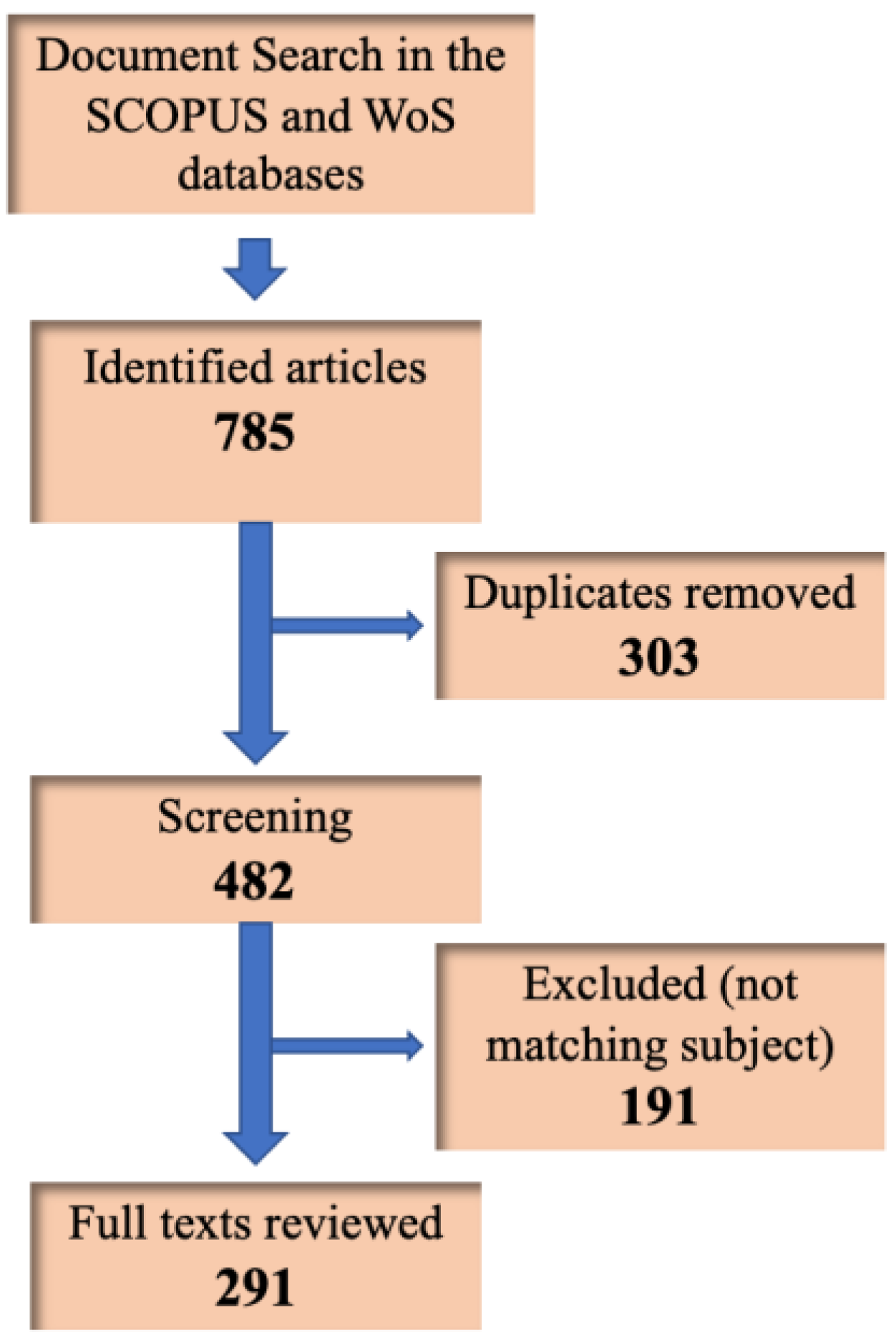
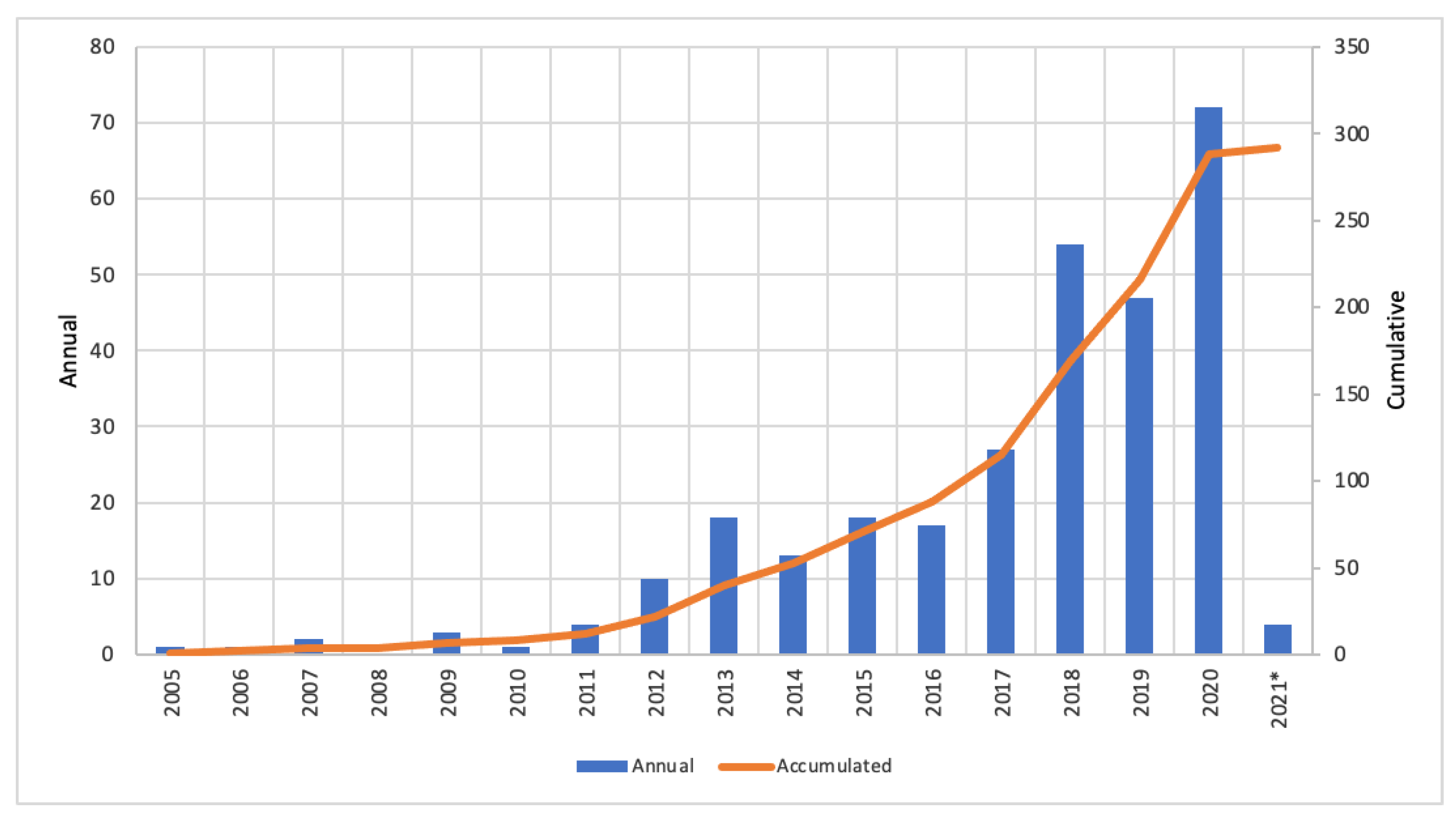
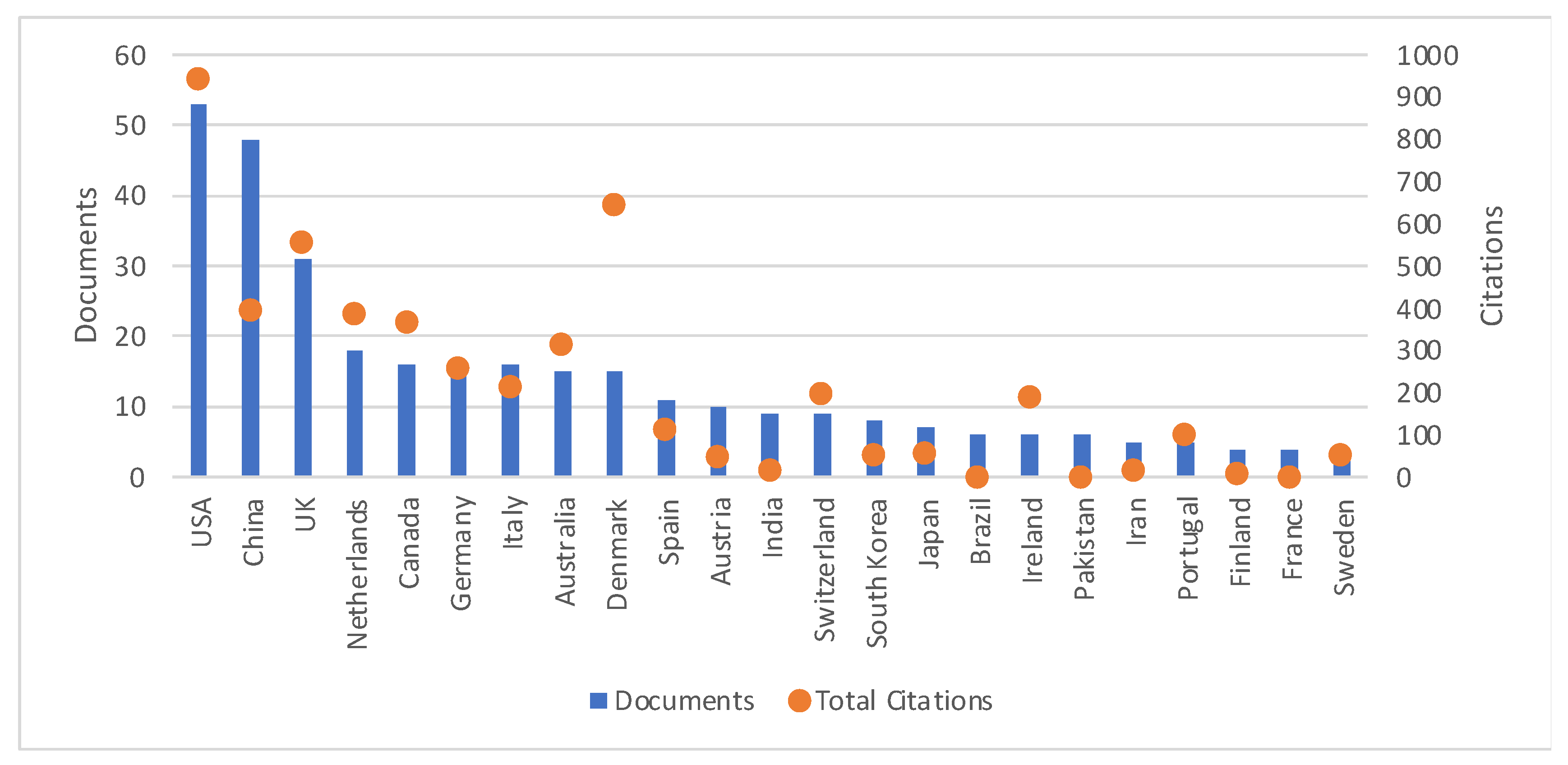

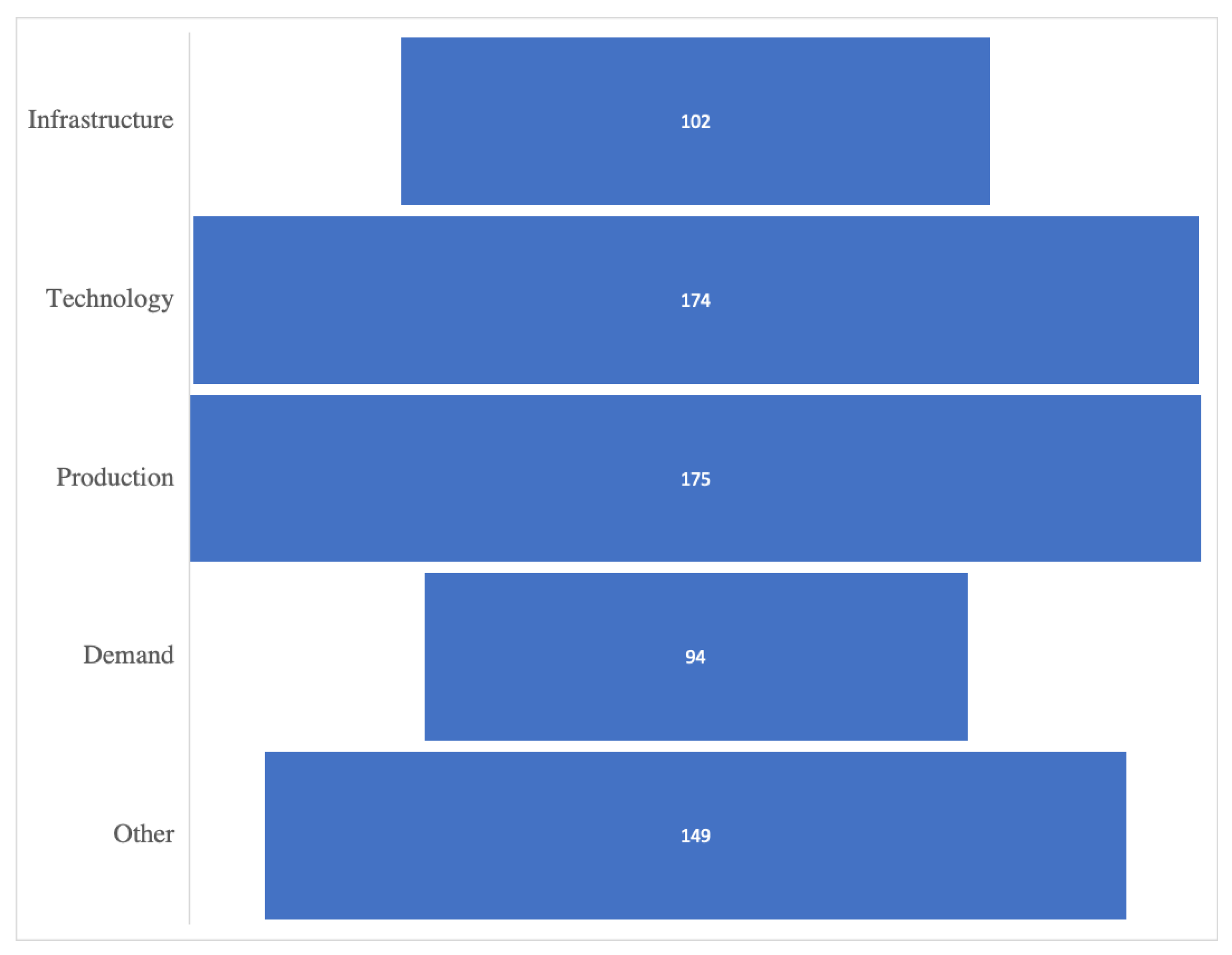

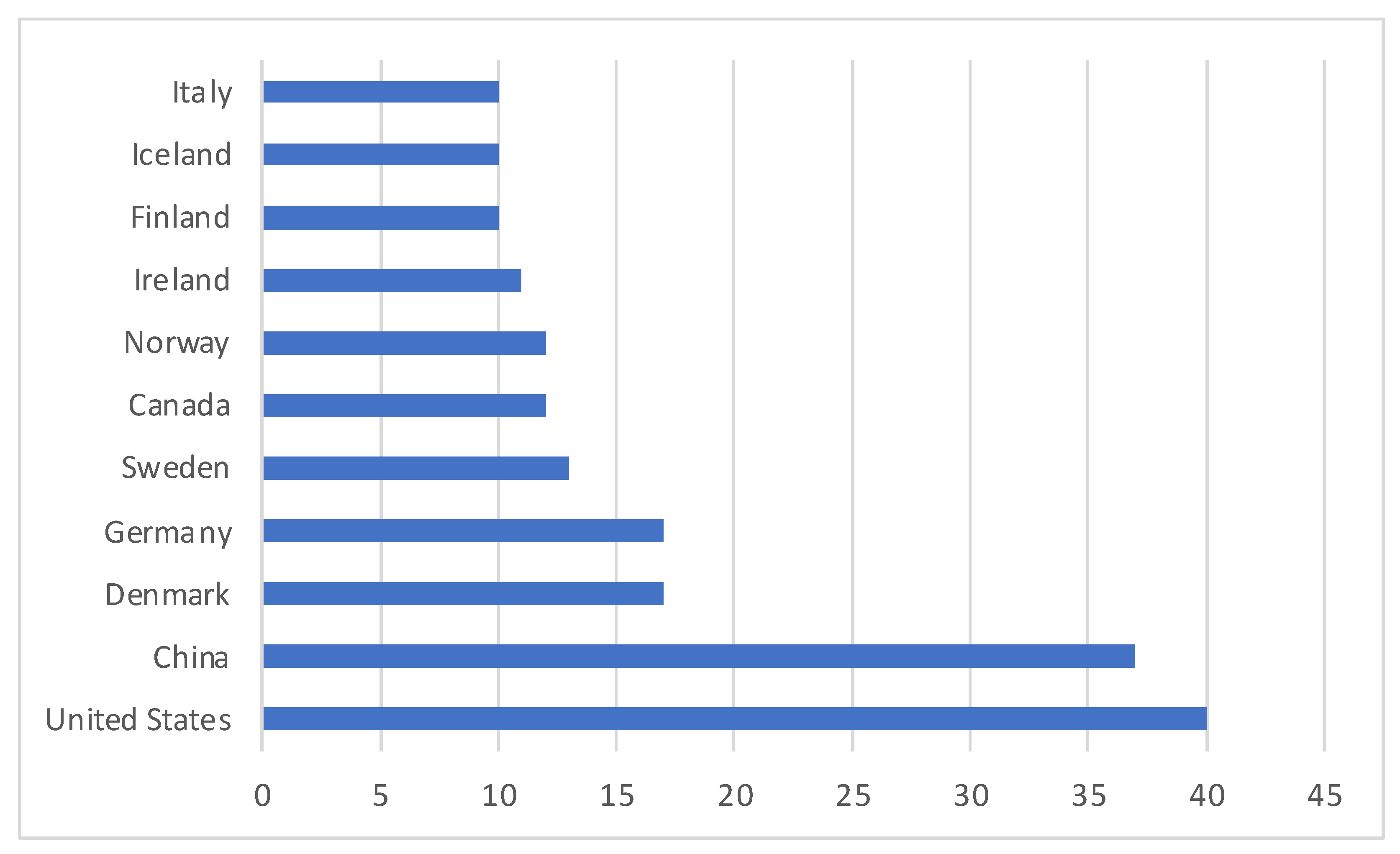
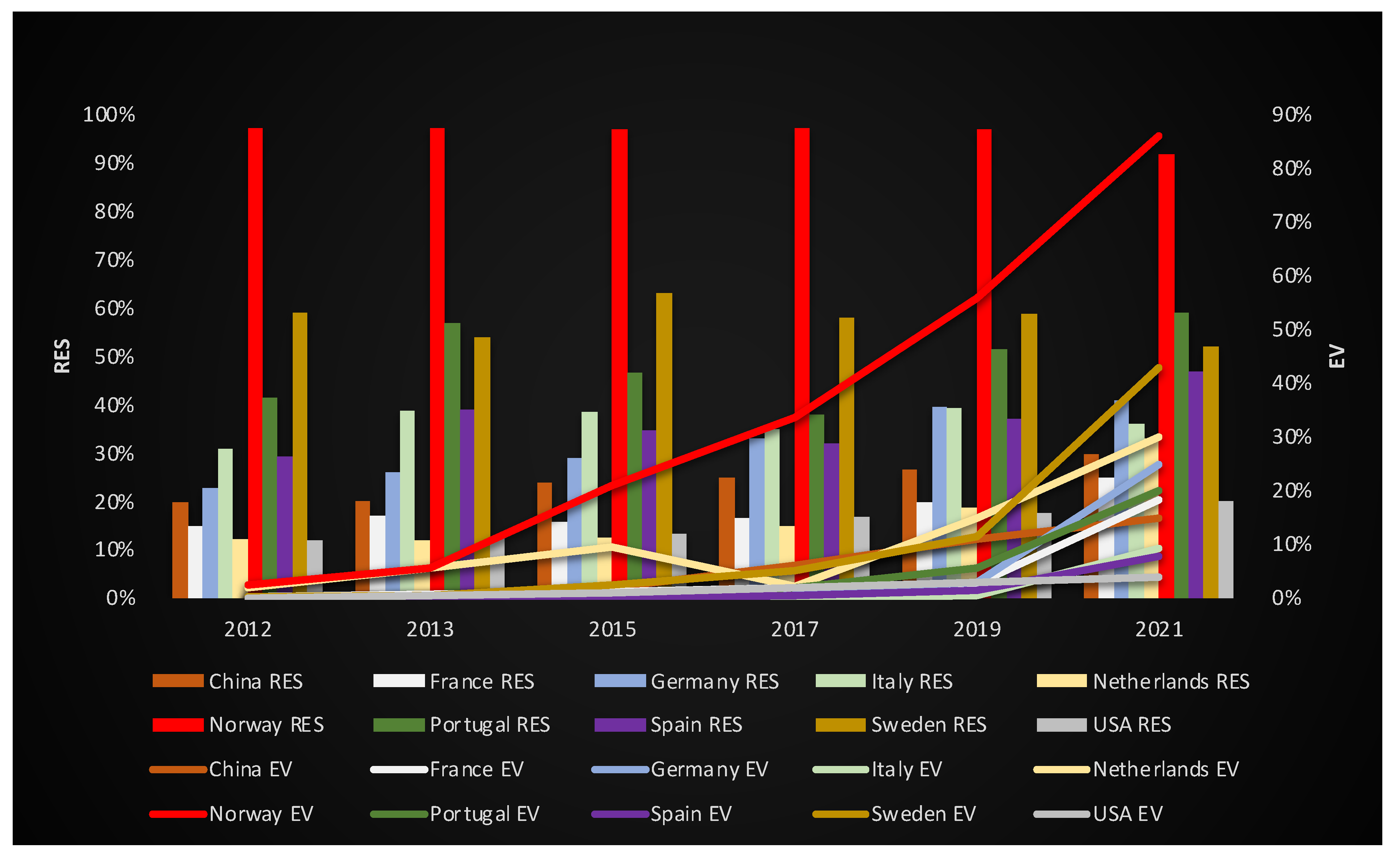
| Paper Methodology | Type of Policy | Geographical Reach |
|---|---|---|
| 100 | 91 | 100 |
| N | Quartile ** | Citations per Document (4 Years) *** | Subject Area *** | |
|---|---|---|---|---|
| Energy Policy | 33 | Q1 | 6.696 | Energy Environmental Science |
| Applied Energy | 28 | Q1 | 10.812 | Energy Engineering Environmental Science |
| Applied Energy | 28 | Q1 | 10.812 | Energy Engineering Environmental Science Mathematics |
| Energy | 20 | Q1 | 7.477 | Energy Engineering Environmental Science Mathematics |
| Journal of Cleaner Production | 18 | Q1 | 9.791 | Business, Management and Accounting Energy Engineering Environmental Science |
| Energies | 16 | Q2 | 3.354 | Energy Engineering Mathematics |
| Paper | Total Citations | Citations per Year |
|---|---|---|
| Sovacool BK, 2009, Energy Policy | 350 | 26.9 |
| Yong JY, 2015, Renewable Sustainable Energy Rev | 257 | 36.7 |
| Ball M, 2015, Int J Hydrogen Energy | 222 | 31.7 |
| Romm J, 2006, Energy Policy | 203 | 12.7 |
| Mathiesen BV, 2009, IET Renew Power Gener | 190 | 14.7 |
| Mathiesen BV, 2009, IET Renew Power Gener | 175 | 21.9 |
| Liserre M, 2016, IEEE Ind Electron Mag | 174 | 29.0 |
| Bauer C, 2015, Appl Energy | 167 | 23.9 |
| Andersen PH, 2009, Energy Policy | 165 | 12.7 |
| Zhang T, 2014, IEEE Trans Veh Technol | 138 | 17.3 |
| Tulpule PJ, 2013, Appl Energy | 138 | 15.3 |
| Zeng X, 2015, Renewable Sustainable Energy Rev | 121 | 17.3 |
| Shafiei E, 2012, Technol Forecast Soc Change | 112 | 11.2 |
| Budde Christensen T, 2012, Energy Policy | 103 | 10.3 |
| Iversen EB, 2014, Appl Energy | 101 | 12.6 |
| Author | Number of Papers |
|---|---|
| Li, J. | 6 |
| Sovacool, B.K. | 6 |
| Li, Y. | 5 |
| Noel, L. | 5 |
| Thiel, C. | 5 |
| Cipcigan, L. | 4 |
| Kester, J. | 4 |
| Shafiei, E. | 4 |
| Zhang, L. | 4 |
| Country | DOP * | TDE ** | INI *** |
|---|---|---|---|
| Austria | ✔ | ✔ | |
| Belgium | ✔ | ||
| Bulgaria | ✔ | ||
| China | ✔ | ✔ | ✔ |
| Croatia | ✔ | ||
| Cyprus | ✔ | ||
| Czech Republic | ✔ | ||
| Denmark | ✔ | ✔ | |
| Finland | ✔ | ✔ | |
| France | ✔ | ✔ | ✔ |
| Germany | ✔ | ✔ | ✔ |
| Greece | ✔ | ||
| Hungary | ✔ | ||
| Iceland | ✔ | ✔ | |
| Ireland | ✔ | ✔ | |
| Italy | ✔ | ✔ | ✔ |
| Latvia | ✔ | ||
| Liechtenstein | |||
| Lithuania | ✔ | ||
| Luxembourg | ✔ | ✔ | |
| Malta | ✔ | ✔ | |
| Netherlands | ✔ | ✔ | ✔ |
| Norway | ✔ | ✔ | ✔ |
| Poland | ✔ | ||
| Portugal | ✔ | ✔ | ✔ |
| Romania | ✔ | ✔ | |
| Slovakia | ✔ | ||
| Slovenia | ✔ | ||
| Spain | ✔ | ✔ | ✔ |
| Sweden | ✔ | ✔ | ✔ |
| Switzerland | ✔ | ✔ | |
| Turkey | ✔ | ||
| United Kingdom | ✔ | ✔ | |
| United States | ✔ | ✔ | ✔ |
| Ukraine | ✔ | ✔ |
Publisher’s Note: MDPI stays neutral with regard to jurisdictional claims in published maps and institutional affiliations. |
© 2022 by the authors. Licensee MDPI, Basel, Switzerland. This article is an open access article distributed under the terms and conditions of the Creative Commons Attribution (CC BY) license (https://creativecommons.org/licenses/by/4.0/).
Share and Cite
Sousa, C.; Costa, E. Types of Policies for the Joint Diffusion of Electric Vehicles with Renewable Energies and Their Use Worldwide. Energies 2022, 15, 7585. https://doi.org/10.3390/en15207585
Sousa C, Costa E. Types of Policies for the Joint Diffusion of Electric Vehicles with Renewable Energies and Their Use Worldwide. Energies. 2022; 15(20):7585. https://doi.org/10.3390/en15207585
Chicago/Turabian StyleSousa, Cristina, and Evaldo Costa. 2022. "Types of Policies for the Joint Diffusion of Electric Vehicles with Renewable Energies and Their Use Worldwide" Energies 15, no. 20: 7585. https://doi.org/10.3390/en15207585







